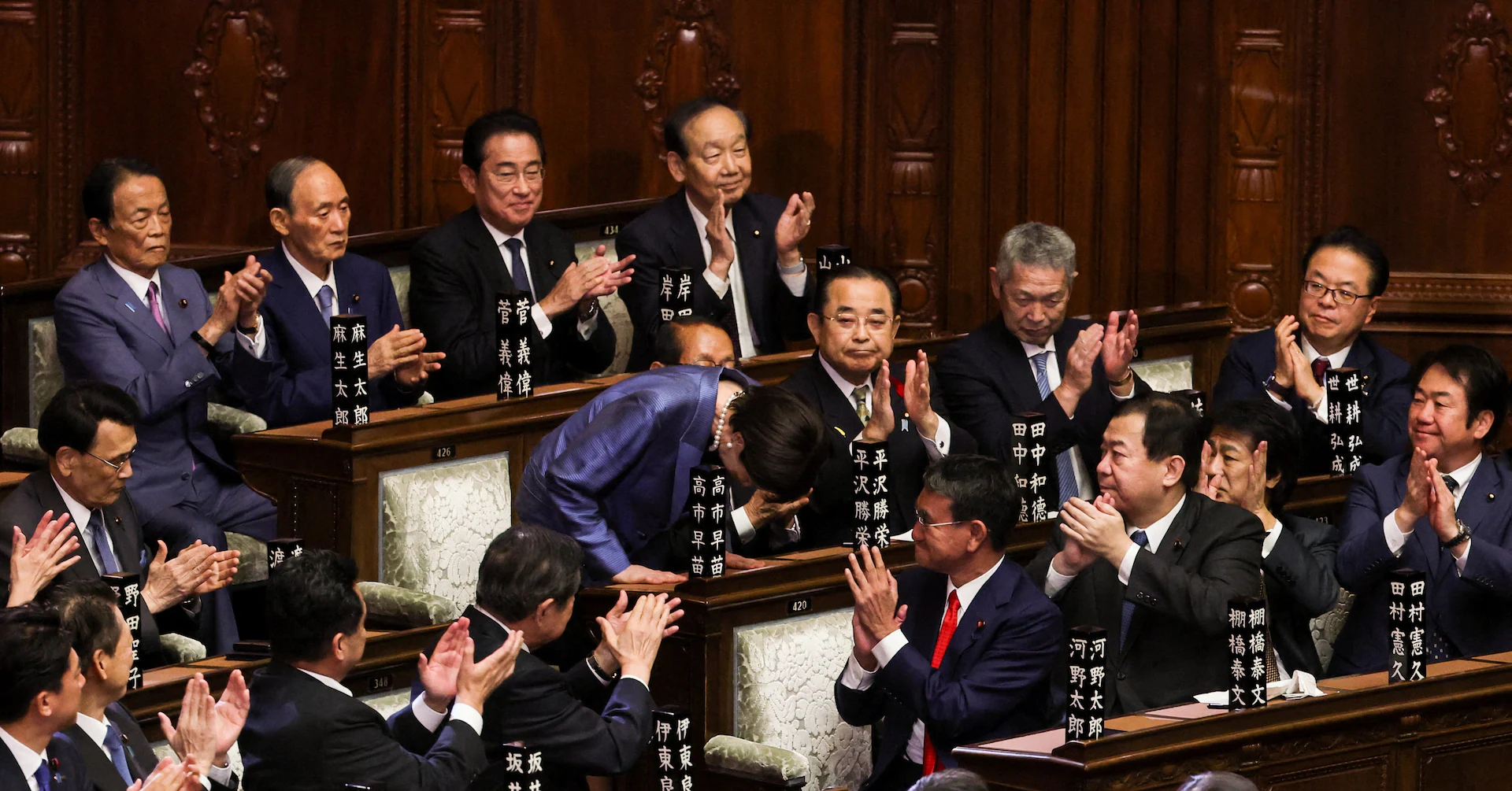Copyright Reuters

Takaichi, who vowed to close Japan's gender gap in the top echelons of politics, has finalised plans to make Satsuki Katayama the first woman to hold the key post of finance minister at a time when the country is worried about rising prices and slow growth. Sign up here. The Nikkei share gauge has surged to record-breaking levels since fiscal dove Takaichi secured a coalition partnership with the right-wing Japan Innovation Party, known as Ishin, to firm up support for her appointment. Below are comments on the appointment: PROF. MIEKO NAKABAYASHI, WASEDA UNIVERSITY "She has never handled foreign affairs directly, so it’s difficult to forecast her approach. She’s made comments that please the right wing, pledging to visit Yasukuni Shrine and taking a tough stance toward South Korea, but whether she sticks to that or shifts to realism remains to be seen. It may be more about rallying the right than conviction. If she really followed through on her words, Japan’s security situation would become dangerous.” MASAMICHI ADACHI, ECONOMIST, UBS SECURITIES JAPAN "PM Takaichi faces challenges including rising prices, a supplementary budget, diplomatic priorities, and reducing Diet seats as agreed with Ishin. Her upcoming policy speech may clarify her 'responsible proactive fiscal policy.' Markets are focused on the fiscal deficit impact of the budget; excessive measures could trigger a Japan sell-off, while insufficient measures may unwind the Takaichi trade and affect approval rates. "Diplomatically, PM Takaichi’s meeting with President Trump next week poses challenges, including potential US demands for increased defense spending and concerns over JPY depreciation. Japan has committed to raising defense spending to 2% of GDP by FY2027, but long-term funding beyond that level remains unresolved. How PM Takaichi navigates U.S. expectations while maintaining favourable relations will be critical." OSAMU TAKASHIMA, CHIEF FX STRATEGIST, CITI, TOKYO "She said that she is the successor of former Prime Minister Shinzo Abe, and she also noted that her economic policy should be similar to Abenomics, which is why the market has a perception that Sanaenomics will be a second version of Abenomics. However, there are so many differences between, say, 10 years ago and the present. Ten years ago, Japan faced deflationary pressure with a strong currency. However, now Japan is facing inflation and a weak currency problem. So the conditions are totally opposite to 10 years ago." "Especially regarding BOJ monetary policy, I don't think she will put pressure on the bank to not raise interest rates. Japan's economic problem is inflation and yen weakness. And inflation and yen weakness are unpopular among the Japanese people. So if she puts political pressure on the BOJ, and the yen depreciates further, then inflation increases more. She could lose popularity among the Japanese people. This would be a very, very risky game for her." TOHRU SASAKI, CHIEF STRATEGIST, FUKUOKA FINANCIAL GROUP "I think the Takaichi trade will continue. The Nikkei will continue to rally and the yen will continue to depreciate. Katayama-san personally does not support big fiscal spending, but since she will be finance minister in the Takaichi cabinet, she probably will not insist strongly on her view. Katayama-san is also suspicious of the effect of FX intervention." TAKASHI KIUCHI, EXECUTIVE ECONOMIST, NOMURA RESEARCH INSTITUTE "The Japan Innovation Party (Ishin) advocates small and efficient government, making it in some ways the opposite of LDP President Sanae Takaichi, who has championed active fiscal spending and monetary easing. Cooperation with Ishin could temper Takaichi’s policy instincts and lead to a more balanced economic approach. "Fiscal management under Takaichi’s administration is likely to be somewhat more proactive than under the previous Ishiba government, but not excessive. Ishin also values the Bank of Japan’s independence, so the likelihood of political interference over continued monetary easing appears low.” NAKA MATSUZAWA, CHIEF MACRO STRATEGIST, NOMURA SECURITIES "I think the market notion of the so-called Takaichi trade has been changing. Initially, the Takaichi trade was meant to be a stock market rally driven by exporter stocks and a steepening, or even twist-steepening of the bond yield curve. "Originally, the market thought Takaichi to be a reflationary, sort of Abenomics-like, policy advocate. But based on her recent statements, Takaichi is not as reflationary as the market initially thought. And the pick of Katayama as finance minister confirms that thinking. Particularly, the coalition with Ishin makes Takaichi less inclined toward reflationary policy. "So, the new Takaichi trade, as I call it, is not driven by yen weakening. It's more driven by structural reforms and strategic investment. "The new Takaichi trade is more of a flattening of the yield curve and a stock market rally driven by the domestic demand stocks, that includes machinery and banking stocks. And they will not let the yen weaken further. "I think the stock market will probably lose momentum after investors realise that Takaichi is not as reflationary as they thought and the yen actually strengthens." SHOKI OMORI, CHIEF DESK STRATEGIST, MIZUHO SECURITIES, TOKYO "Since Ms. Takaichi became LDP leader, the USD/JPY exchange rate has exhibited a clear tendency to test higher levels. "Recent yen strength to roughly Y151 per dollar reflects temporary adjustments associated with concerns over U.S. banking-sector credit conditions and ongoing United States–China tariff issues. Should market confidence regarding these matters improve, the dollar–yen rate is expected to resume its upward trajectory under the Takaichi administration. "Ms. Takaichi's broadly dovish macroeconomic stance is balanced by a pragmatic understanding of the BOJ's gradual normalisation of interest rates. A single 25-basis-point policy-rate increase around the end of this year or the beginning of next year cannot be ruled out, yet the pace of subsequent adjustments is expected to be considerably slower than in recent tightening phases." CHRISTOPHER WONG, CURRENCY STRATEGIST, OCBC, SINGAPORE: "The move was expected after JIP agreed to form a coalition. Perceived fiscal prudence from the LDP-JIP coalition should be reassuring for markets and the yen. Impact on dollar/yen this episode will likely not be similar to the move seen post-LDP election as Takaichi’s previous pro-stimulus stance may have to be compromised. Also, one less political uncertainty may potentially pave the way for BOJ to hike on October 30, given that macro conditions allow for policy normalisation." HIROFUMI SUZUKI, CHIEF FX STRATEGIST, SMBC, TOKYO: "While fiscal stimulus is expected, it is unlikely to be bold given the difficulties of policy management. A sharp depreciation of the yen is likely to be avoided, with gentle downward pressure on the yen expected to persist."



